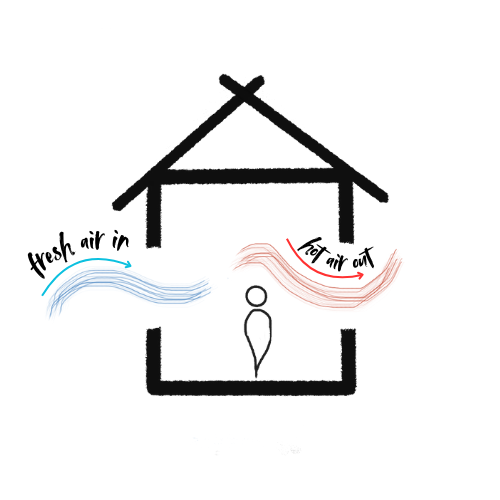Daylight & Sunlight Studies
In my journey through environmental design, I have understood how important natural lighting studies are in sustainable construction and how great an impact proper natural lighting has on occupants’ well-being. Studies suggest that natural light has been shown to improve mood, increase productivity and even regulate sleep patterns. This aspect highlights the importance of integrating bioclimatic analyses in the design phase to ensure that buildings are not only energy efficient, but also spaces where people thrive and feel comfortable.
Additionally, the use of natural lighting software helps us make informed decisions about glass properties, shading devices and also in the development of the internal layout of environments. These tools allow us to predict and mitigate possible problems, such as glare or overheating caused by excessive exposure to direct sunlight, thus harmonising natural lighting with thermal comfort.
PS: If you want to know more about thermal comfort, I have written a post explaining in detail the techniques and tools for this type of analysis and you can access it by clicking here.
Daylight vs Sunlight
But first, what is the difference between daylight and sunlight?
Daylight and sunlight, although frequently used interchangeably, refer to two different aspects of natural light.
Sunlight is the direct light we receive from the sun. It is a powerful light source and can significantly impact the temperature inside a building. In terms of building design, controlled exposure to sunlight can help with natural heating of spaces during colder months, reducing the need for artificial heating. However, uncontrolled sunlight can lead to overheating during warmer months and can cause glare, which is uncomfortable for the eyes.
On the other hand, daylight refers to both direct sunlight and diffuse light that is scattered in the atmosphere. It encompasses all the natural light we see during the day, whether it comes from direct sunlight, diffuse radiation from the sky or light reflected from the ground and other surfaces. Daylight is generally softer and more diffuse compared to direct sunlight.
Managing Heat Gain and Shading Devices
As mentioned previously, in sustainable construction, managing heat gain is a crucial aspect. This becomes especially important in areas exposed to significant sunlight, where the risk of overheating can compromise comfort and energy efficiency. Insolation studies and bioclimatic analysis guide us to understand how sunlight interacts with architectural structures, ensuring that buildings remain cool and energy consumption is minimised. Shading devices play a fundamental role in this process. They mitigate the impact of direct sunlight, reducing internal temperature and dependence on artificial cooling systems.
When used correctly, shading devices can also combat the problem of glare. This can improve the usability of areas and the comfort of people in them. By diffusing or blocking direct sunlight, these tools improve visual comfort, allowing people to enjoy natural light without the negative effects of glare. This balance is crucial in work environments, where screen visibility is very important, and in residential environments, where visual comfort translates into a better quality of life.
In addition to thermal comfort and glare reduction, shading devices contribute to privacy. Depending on the design and positioning, these devices can protect interiors from external views without compromising the penetration of natural light. In this way, inhabitants enjoy abundant natural light alongside the privacy that modern lifestyles demand.
Through daylighting simulation and specialised software, professionals can predict and visualise the impact of different shading solutions, guiding design considerations towards the most suitable option for each unique context. These technologies allow for a detailed approach to sustainable design, where natural light enhances spaces without compromise.
External Shading vs Internal Shading
Choosing the right shading devices is a crucial decision that affects heat gain, user flexibility and energy efficiency. Below I have listed external and internal shading options and their roles in daylighting management.
- External shading blocks solar radiation before it enters a space. This method drastically reduces heat gain and helps reduce dependence on cooling systems, contributing positively to a building’s environmental impact. Systems such as eaves, brise-soleil and screens are customisable for architectural aesthetics while simultaneously working to naturally cool buildings.
- Internal shading, such as curtains, blinds and venetian blinds, offers occupants the ability to adjust light levels and privacy. Although not as effective in reducing heat gain as their external counterparts, internal devices provide invaluable adaptability. Users control their environment based on daily or seasonal needs, enhancing visual comfort without significantly compromising natural light intake.
Note that, with advances in technology, it is now possible to incorporate adaptive external shading systems into building designs. A perfect example is the parametric facades seen in the Al Bahr Towers in Abu Dhabi, designed by Aedas Architects. These facades are designed to respond to the position of the sun and adjust accordingly to optimise shading and reduce heat gain within the building.
Although this type of system offers significant benefits in terms of energy efficiency and visual comfort, it is important to note that it is not as simple to implement as internal shading systems. Additionally, the cost associated with these advanced external shading systems is typically higher. However, the long-term benefits in energy savings and occupant comfort may justify this initial investment. I have a post talking about the use of Cobogó in buildings and its benefits for natural lighting control and thermal comfort, which you can access by clicking here.

Adaptive Shading in facade – Al Bahr Towers, Abu Dhabi by Aedas Architects.
Investing in daylighting software helps find the optimal balance between these types of shading for any specific project. The available tools allow designers to model and predict the performance of external and internal shading systems under different conditions. This simulation process ensures that design choices are supported by thorough analysis, leading to aesthetically pleasing and functionally sustainable spaces.
The choice between external and internal shading is not binary, but rather a strategic decision based on the specific needs of the project. Incorporating sunlight analysis early in the design phase allows for informed selections that contribute to a building’s sustainability goals. Ultimately, adopting the right combination of shading techniques becomes a crucial step to improve energy efficiency, occupant comfort and the overall success of sustainable constructions.
Solar Control Options and Glazing Properties
Solar control options and glass properties also play a critical role in sustainable design, directly influencing thermal comfort within buildings and the building’s energy consumption. The ability to control the amount of sunlight that enters a space allows us to manipulate internal temperatures and lighting levels, contributing significantly to occupant comfort and reducing dependence on cooling and artificial lighting. This is where a basic understanding of glass properties is really useful.
Different types of glass can drastically alter the thermal and optical characteristics of windows. For example, low-emissivity (low-e) glass uses a thin microscopic coating to minimise the amount of infrared and ultraviolet light that passes through the glass without compromising the amount of visible light transmitted. This means that interiors remain illuminated while being protected against heat gain and harmful radiation. On the other hand, tinted glass works by absorbing a significant portion of incoming solar radiation, thus reducing the heat that enters the space. The choice between these glass options or others should consider both the impact on heat gain and the visual and lighting effects on the internal environment.
Of course, careful selection of glass can improve natural lighting, reduce energy costs and improve the quality of the internal environment. Through bioclimatic analyses and daylighting simulation, we can predict the performance of different types of glass under various conditions, assisting in the creation of spaces that are not only visually comfortable, but also thermally regulated. By integrating careful solar control strategies and selecting appropriate glass properties, sustainable constructions can achieve a balance between maximising natural light and minimising unwanted heat gains, leading us towards more resilient and energy-efficient buildings.
Design Considerations for Natural Lighting Integration
Designing with natural lighting involves a blend of art and science. It is important to consider multiple factors to ensure that natural lighting enriches a project without compromising the comfort and energy efficiency of the space. Here is an overview of the key considerations and strategies.
First, it is important to conduct a comprehensive bioclimatic analysis. This step assesses the geographical location, climate and local environmental conditions. Computer simulations, including daylight autonomy and useful daylight illuminance, inform the initial phases of the project, providing a data-based foundation for making informed decisions about the building’s orientation, layout and facade design.
Next, the choice and location of shading devices play a fundamental role. Whether opting for internal or external shading, I balance the need to minimise heat gain and glare with the desire to maximise natural light. The selection between external and internal shading devices depends on the specifics of the project, including the building orientation and local climate.
Glass properties also require careful selection. It is essential to evaluate the trade-offs between different types of glass, considering factors such as light transmission, solar gain and thermal performance. Glazing choices, including low-emissivity and smart glasses, are tailored to enhance natural lighting while effectively managing heat transfer.
Finally, the integration of natural lighting in sustainable constructions requires a comprehensive understanding of the benefits and challenges associated with natural light. By meticulously balancing these factors, it is possible to design spaces that not only meet energy efficiency standards, but also enhance occupants’ well-being and connect them to the surrounding environment.
Computational Daylighting Analysis Tools
Here are some software options for conducting Daylight and Sun studies:
- Ladybug Tools: A plugin for Grasshopper, a visual programming language in Rhino 3D. For sunlight simulations, it allows the creation of 3D models of buildings and their environments and performs detailed sunlight analyses. It can visualise sunlight exposure, daylight autonomy and glare analysis, among other metrics.
- Climate Studio: This software is specifically designed for sustainable design, providing detailed climate analysis, including insolation studies. It can simulate direct and diffuse daylight, glare potential and solar heat gain, providing clear visualisations and data to guide design decisions.
- IES: Integrated Environmental Solutions (IES) offers a suite of tools that allow for comprehensive building performance modelling. It can perform detailed daylight, sunlight and glare simulations, and even conduct climate-based daylight modelling. The software makes it possible to analyse a building’s exposure to natural light throughout the year, and optimise the position of windows and shading devices to maximise daylight, minimising glare and overheating.
In conclusion, insolation and daylight studies are fundamental for sustainable constructions. They guide us to make informed decisions that promote energy efficiency, occupant comfort and environmental preservation. By adopting these strategies, we reaffirm our commitment to designing buildings that not only serve their inhabitants, but also protect and preserve our planet.buildings that not only cater to their inhabitants but also protect and preserve our planet.







This was a very good post. Check out my web page UY7 for additional views concerning about Airport Transfer.